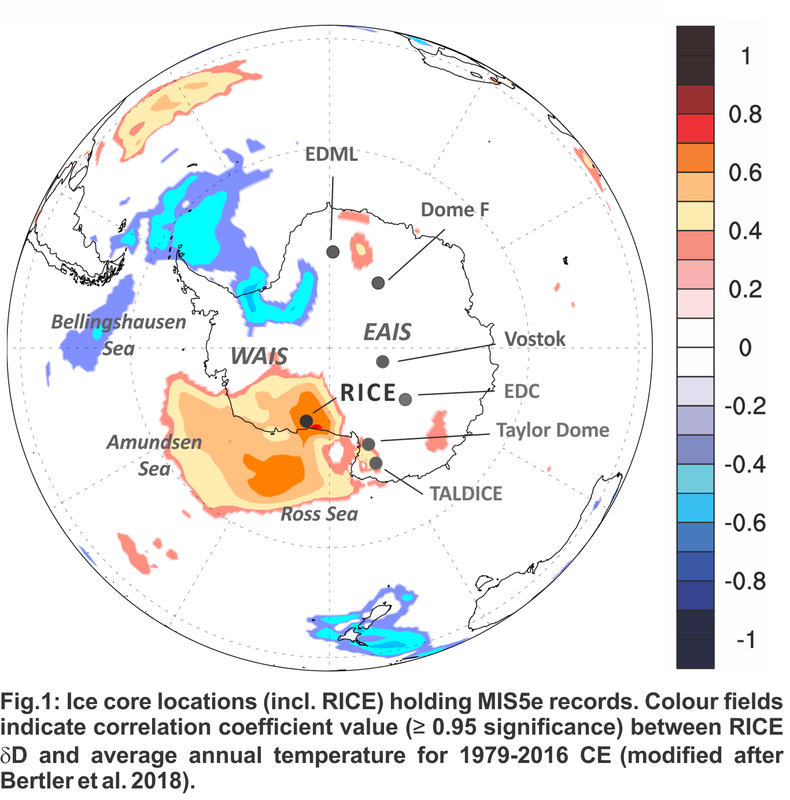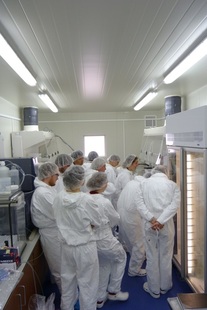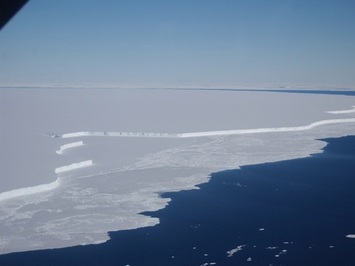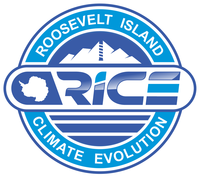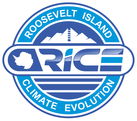Two fully funded PhD positions to investigate the last interglacial warm period in Antarctica (24 Mar 2021)
We are offering two PhD scholarships to explore ice core data-constrained modelling efforts to improve our understanding of Antarctica’s contribution to sea level rise during the last interglacial warm period.
Application deadline: 31 May 2021 Science Focus In a rapidly warming world, the potentially catastrophic deglaciation of the West Antarctic Ice Sheet (WAIS) remains a primary cause of uncertainty in Intergovernmental Panel on Climate Change (IPCC) sea level rise projections1. Updated global mean sea level rise projections suggest that atmospheric warming exceeding the Paris Agreement target, will commit WAIS and perhaps East Antarctica’s marine based ice sheets (ice grounded below sea level) to irreversible retreat causing global sea level to rise2. Urgently needed adaption strategies are hampered by large inter-model variability and poorly quantified uncertainties in future projections3. Applying the IPCC high emission scenario (RCP 8.5), sea level projections to 2100 range from 0.7 to 1.7 m2,4,5 by 2100. The large range of inter-model variability of future projections suggests that key physical processes and their effects are not yet adequately captured or understood, leading to important uncertainties6,7. | |||||||
Reconstructions of relevant past time slices provide valuable constraints for improving model performance, and offer key insights into feedbacks, thresholds, and climate sensitivities2,4-6,8. A particularly useful example is the Last Interglacial period (LIG, 130-115 thousand years [ka] ago), also referred to as Marine Isotope Stage 5e (MIS 5e), when CO2 concentration was 30% lower, global temperature 1-1.5°C warmer, and global sea level 6-9 m higher than today9. During this period, Greenland’s sea level contribution has been constrained to ≤2 m10. With an additional ~1 m derived from the thermal expansion of the ocean, this implies a contribution from the marine-based WAIS of up to 3.3 m sea level equivalent, with marine-based sectors of the East Antarctic Ice Sheets (EAIS) potentially contributing the remainder (0-2.7 m)9.
Thus, WAIS and perhaps the marine-based regions of East Antarctica and their buttressing ice shelves appear to be highly sensitive to oceanic and atmospheric feedbacks9 within the relatively small temperature increases that are relevant to the goals of the Paris Agreement. Six existing East Antarctic ice cores contain MIS 5e records11,12 but they do not hold information on the WAIS12,13. This project takes advantage of the Roosevelt Island Climate Evolution (RICE) ice core, the first West Antarctic MIS 5e record, to answer the question: Did the WAIS collapse when global temperatures were 1-2°C higher than today?
Thus, WAIS and perhaps the marine-based regions of East Antarctica and their buttressing ice shelves appear to be highly sensitive to oceanic and atmospheric feedbacks9 within the relatively small temperature increases that are relevant to the goals of the Paris Agreement. Six existing East Antarctic ice cores contain MIS 5e records11,12 but they do not hold information on the WAIS12,13. This project takes advantage of the Roosevelt Island Climate Evolution (RICE) ice core, the first West Antarctic MIS 5e record, to answer the question: Did the WAIS collapse when global temperatures were 1-2°C higher than today?
PhD Scholarships
We are offering two fully funded PhD positions. One based in New Zealand and one first based in the UK and then in New Zealand.
Assessing Antarctic environmental change and ocean-ice-atmosphere interactions during the last Interglacial using data-constrained Earth system models (Supervisors: Liz Keller and Nancy Bertler)
This fully funded PhD position is available at the Antarctic Research Centre (ARC), Victoria University of Wellington, in collaboration with GNS Science to develop an environmental reconstruction of the Ross Sea region during MIS 5e using data-constrained intermediate complexity Earth system models. The successful candidate will be hosted by the ARC and collaborate with international scientists and graduate students from the ARC and GNS Science. The candidate will be part of the new National Modelling Hub and will have access to excellent technical support, high-performance computing, statistical modelling, climate models, and mentorship from senior researchers.
Location: New Zealand/ Victoria University and GNS Science
Scholarship: NZ$27,500 pa + full fees for 3 years
Supervisors: Liz Keller ([email protected]) and Nancy Bertler ([email protected])
Eligibility: The ideal candidate will hold an MSc degree. An excellent grade / GPA is required.
Criteria: The candidate has a background in one or more of the following fields
Reduced Antarctic ice volume and sea ice during the last interglacial: The RICE ice core and climate modelling with isotopes (Supervisors: Louise Sime and Nancy Bertler)
A fully funded PhD position is available at the Antarctic Research Centre (ARC) in collaboration with British Antarctic Survey and GNS Science to develop last interglacial (during MIS 5e) environmental reconstructions in the Ross Sea region of Antarctica using new isotope measurements from the RICE ice core alongside a suite of isotope-enabled climate models. Initially it was planned for the student to travel between NZ and the UK to develop their thesis work. With Covid-19 travel restrictions, the successful candidate will now be hosted for the first 12-18months by the British Antarctic Survey and will then move to New Zealand to be hosted by the ARC and GNS Science. Being part of the new and new National Modelling Hub, the candidate has access to excellent technical support, high-performance computing, statistical modelling, climate modelling, and, and mentorship from senior researchers.
Location: United Kingdom / British Antarctic Survey AND New Zealand Victoria University and GNS Science. It is anticipated that this PhD project will be hosted for the first 12-18 months by the British Antarctic Survey in Cambridge, UK, and the remaining time at Victoria University of Wellington and GNS Science in Wellington, New Zealand.
Scholarship: NZ$27,500 pa + full fees for 3 years
Supervisors: Louise Sime ([email protected]) and Nancy Bertler ([email protected])
Eligibility: The ideal candidate will hold an MSc degree. An excellent grade / GPA is required.
Criteria: The candidate has a background in one or more of the following fields
Dr Louise Sime would also like to draw your attention to the related EU-DEEPICE Climate-Ocean modeller PhD studentship https://www.bas.ac.uk/jobs/vacancy/climate-ocean-modeller-deepice-2/ (short deadline 31th March)
More Details:
For further information please contact the relevant researchers:
Liz Keller ([email protected])
Louise Sime ([email protected])
Nancy Bertler ([email protected])
Application Process
To apply for either PhD position, please send the relevant supervisors by 31 May 2021:
We are offering two fully funded PhD positions. One based in New Zealand and one first based in the UK and then in New Zealand.
Assessing Antarctic environmental change and ocean-ice-atmosphere interactions during the last Interglacial using data-constrained Earth system models (Supervisors: Liz Keller and Nancy Bertler)
This fully funded PhD position is available at the Antarctic Research Centre (ARC), Victoria University of Wellington, in collaboration with GNS Science to develop an environmental reconstruction of the Ross Sea region during MIS 5e using data-constrained intermediate complexity Earth system models. The successful candidate will be hosted by the ARC and collaborate with international scientists and graduate students from the ARC and GNS Science. The candidate will be part of the new National Modelling Hub and will have access to excellent technical support, high-performance computing, statistical modelling, climate models, and mentorship from senior researchers.
Location: New Zealand/ Victoria University and GNS Science
Scholarship: NZ$27,500 pa + full fees for 3 years
Supervisors: Liz Keller ([email protected]) and Nancy Bertler ([email protected])
Eligibility: The ideal candidate will hold an MSc degree. An excellent grade / GPA is required.
Criteria: The candidate has a background in one or more of the following fields
- Earth System Modelling
- Paleoclimate reconstructions/Earth Sciences
- Ice core proxy development and reconstruction
- Physics
- Computer Science
- Oceanography
- Meteorology or atmospheric science
- Some basic programming skills are required (e.g. Python, R, , C/C++, Fortran, command line scripting)
Reduced Antarctic ice volume and sea ice during the last interglacial: The RICE ice core and climate modelling with isotopes (Supervisors: Louise Sime and Nancy Bertler)
A fully funded PhD position is available at the Antarctic Research Centre (ARC) in collaboration with British Antarctic Survey and GNS Science to develop last interglacial (during MIS 5e) environmental reconstructions in the Ross Sea region of Antarctica using new isotope measurements from the RICE ice core alongside a suite of isotope-enabled climate models. Initially it was planned for the student to travel between NZ and the UK to develop their thesis work. With Covid-19 travel restrictions, the successful candidate will now be hosted for the first 12-18months by the British Antarctic Survey and will then move to New Zealand to be hosted by the ARC and GNS Science. Being part of the new and new National Modelling Hub, the candidate has access to excellent technical support, high-performance computing, statistical modelling, climate modelling, and, and mentorship from senior researchers.
Location: United Kingdom / British Antarctic Survey AND New Zealand Victoria University and GNS Science. It is anticipated that this PhD project will be hosted for the first 12-18 months by the British Antarctic Survey in Cambridge, UK, and the remaining time at Victoria University of Wellington and GNS Science in Wellington, New Zealand.
Scholarship: NZ$27,500 pa + full fees for 3 years
Supervisors: Louise Sime ([email protected]) and Nancy Bertler ([email protected])
Eligibility: The ideal candidate will hold an MSc degree. An excellent grade / GPA is required.
Criteria: The candidate has a background in one or more of the following fields
- Earth System Modelling
- Paleoclimate reconstructions/Earth Sciences
- Ice core proxy development and reconstruction
- Physics
- Computer Science
- Oceanography
- Meteorology or atmospheric science
- Some basic programming skills are required (e.g. Python, R, , C/C++, Fortran, command line scripting)
Dr Louise Sime would also like to draw your attention to the related EU-DEEPICE Climate-Ocean modeller PhD studentship https://www.bas.ac.uk/jobs/vacancy/climate-ocean-modeller-deepice-2/ (short deadline 31th March)
More Details:
For further information please contact the relevant researchers:
Liz Keller ([email protected])
Louise Sime ([email protected])
Nancy Bertler ([email protected])
Application Process
To apply for either PhD position, please send the relevant supervisors by 31 May 2021:
- A cover letter (please include the PhD position you apply for)
- Your CV
- Contact details of two referees
New Funding to Investigate Environmental Conditions during the Last Interglacial Period (2020)
Rapid deglaciation of the West Antarctic Ice Sheet remains a primary uncertainty in global sea level rise projections, with the potential to affect hundreds of millions of people. On 4 November 2016, the United Nation Framework Convention on Climate Change Paris Agreement came into force with the ambition to limit global warming to 1.5-2°C above the preindustrial baseline. But will this be sufficient, or are we committing the West Antarctic Ice Sheet to irreversible collapse, adding >3 m to global sea level? We will use information locked in the Antarctic ice itself to study the last interglacial period, some 130,000-115,000 years ago. Then, global mean temperature was 1-1.5°C warmer than the preindustrial baseline and, importantly, global sea level was 6-9 m higher than today. We will take advantage of a new ice core record, avant guarde analytical and modelling capabilities to develop the first detailed reconstruction of West Antarctic environmental conditions and its contribution to sea level rise during this time. The research will allow us to critically assess, and hence improve, future projections on how, when, and how quickly the West Antarctic Ice Sheet might collapse, as we race to fulfil the ambitious goals of the Paris Agreement.
This 3-year project started on 01 Jan 2021. The project team includes: Dr. Ruzica Dadic, Dr. Liz Keller, Prof. Nick Golledge, Prof. Jeff Severinghaus, Prof. Ed Brook, Prof. Dorthe Dahl-Jensen, Dr. Louise Sime, Prof. Thomas Blunier, Prof. Howard Conway, Dr. Richard Hindmarsh, Associate Prof. Rob McKay and Associate Prof. Nancy Bertler.
For more information please contact Associate Prof. Nancy Bertler ([email protected]; [email protected]).
This 3-year project started on 01 Jan 2021. The project team includes: Dr. Ruzica Dadic, Dr. Liz Keller, Prof. Nick Golledge, Prof. Jeff Severinghaus, Prof. Ed Brook, Prof. Dorthe Dahl-Jensen, Dr. Louise Sime, Prof. Thomas Blunier, Prof. Howard Conway, Dr. Richard Hindmarsh, Associate Prof. Rob McKay and Associate Prof. Nancy Bertler.
For more information please contact Associate Prof. Nancy Bertler ([email protected]; [email protected]).
New RICE Dating Paper - An 83 000-year-old ice core from Roosevelt Island, Ross Sea, Antarctica (20 Sep 2020)
The Roosevelt Island ice core was drilled to investigate climate from the eastern Ross Sea, West Antarctica. We describe the ice age-scale and gas age-scale of the ice core for 0–763 m (83 000 years BP). Old ice near the bottom of the core implies the ice dome existed throughout the last glacial period and that ice streaming was active in the region. Variations in methane, similar to those used as evidence of early human influence on climate, were observed prior to significant human populations.
You can download the publication here:
James E. Lee, Edward J. Brook, Nancy A. N. Bertler, Christo Buizert, Troy Baisden, Thomas Blunier, V. Gabriela Ciobanu, Howard Conway, Dorthe Dahl-Jensen, Tyler J. Fudge, Richard Hindmarsh, Elizabeth D. Keller, Frédéric Parrenin, Jeffrey P. Severinghaus, Paul Vallelonga, Edwin D. Waddington, and Mai Winstrup - Climate of the Past, 16, 1691–1713, https://doi.org/10.5194/cp-16-1691-2020, 2020
New 3-year RICE Postdoctoral Fellowship - closed
GNS Science is seeking a scientist experienced in the analysis and interpretation of ice cores. The successful applicant will be part of our Global Change Through Time Programme working on the Roosevelt Island Climate Evolution (RICE) ice core project. RICE (www.rice.aq) is a New Zealand led, 9-nation collaboration which focuses on past, current and future sea level contributions from the West Antarctic Ice Sheet. An important focus for this role will be the development the annually resolved Holocene major ion record to reconstruct environmental conditions and ice/ocean/atmosphere interactions during a time period of extensive Ross Ice Shelf grounding line retreat. An important focus will be the analyses of ice core samples at our National Ice Core Research Facility, and the integration of the RICE data with existing ice cores and records from New Zealand and the Southern Ocean. Our laboratory uses state-of-the-art continuous flow and discrete analytical methods and we work closely with earth system and ice sheet modellers to improve modelling skill and help constrain future projections.
Suitably qualified candidates are expected to have a PhD in earth sciences or a closely related discipline. Preferred applicants would have post graduate experience undertaking such research in collaborative teams particularly producing and interpreting geochemical and isotopic ice core records.
The demonstrated ability to identify, lead or contribute to funding applications and to publish research results through lead authoring or co-authoring scientific publications, paper or reports is desirable.
How to apply: Applications close on Monday 28 July 2019. To be considered candidates must submit their application through the Science New Zealand site (https://careers.sciencenewzealand.org/jobdetails/ajid/ukiR8/Postdoctoral-Fellow-in-Ice-Core-Paleoclimatology,33745.html)
For more information please contact Associate Prof. Nancy Bertler ([email protected]; [email protected]; https://www.victoria.ac.nz/antarctic/about/staff/nancy-bertler).
Suitably qualified candidates are expected to have a PhD in earth sciences or a closely related discipline. Preferred applicants would have post graduate experience undertaking such research in collaborative teams particularly producing and interpreting geochemical and isotopic ice core records.
The demonstrated ability to identify, lead or contribute to funding applications and to publish research results through lead authoring or co-authoring scientific publications, paper or reports is desirable.
How to apply: Applications close on Monday 28 July 2019. To be considered candidates must submit their application through the Science New Zealand site (https://careers.sciencenewzealand.org/jobdetails/ajid/ukiR8/Postdoctoral-Fellow-in-Ice-Core-Paleoclimatology,33745.html)
For more information please contact Associate Prof. Nancy Bertler ([email protected]; [email protected]; https://www.victoria.ac.nz/antarctic/about/staff/nancy-bertler).
New RICE Community Paper
The manuscript - The Ross Sea Dipole - Temperature, Snow Accumulation and Sea Ice Variability in the Ross Sea Region, Antarctica, over the Past 2,7000 Years - takes advantage of the development of the RICE17 age scale which is based on an annual layer count for the past 2,700 years (Winstrup et al. to be submitted) and matching of high resolution methane measurements to the WAIS Divide and NEEM ice cores in West Antarctica and Greenland respectively (Lee et al., to be submitted). Our data show that for the past 2,700 years, the eastern Ross Sea warmed while the western Ross Sea showed no trend and West Antarctica cooled. From the 17th Century, all three regions warm, with dynamic changes in snow accumulation trends. A Ross Sea Dipole – opposing trends in the eastern and western Ross – Sea, is observed since the 3rd Century but is masked by longer-term trends.
You can download the publication here:
Reference: Bertler, N. A. N., Conway, H., Dahl-Jensen, D., Emanuelsson, D. B., Winstrup, M., Vallelonga, P. T., Lee, J. E., Brook, E. J., Severinghaus, J. P., Fudge, T. J., Keller, E. D., Baisden, W. T., Hindmarsh, R. C. A., Neff, P. D., Blunier, T., Edwards, R., Mayewski, P. A., Kipfstuhl, S., Buizert, C., Canessa, S., Dadic, R., Kjær, H. A., Kurbatov, A., Zhang, D., Waddington, E. D., Baccolo, G., Beers, T., Brightley, H. J., Carter, L., Clemens-Sewall, D., Ciobanu, V. G., Delmonte, B., Eling, L., Ellis, A., Ganesh, S., Golledge, N. R., Haines, S., Handley, M., Hawley, R. L., Hogan, C. M., Johnson, K. M., Korotkikh, E., Lowry, D. P., Mandeno, D., McKay, R. M., Menking, J. A., Naish, T. R., Noerling, C., Ollive, A., Orsi, A., Proemse, B. C., Pyne, A. R., Pyne, R. L., Renwick, J., Scherer, R. P., Semper, S., Simonsen, M., Sneed, S. B., Steig, E. J., Tuohy, A., Venugopal, A. U., Valero-Delgado, F., Venkatesh, J., Wang, F., Wang, S., Winski, D. A., Winton, V. H. L., Whiteford, A., Xiao, C., Yang, J., and Zhang, X.: The Ross Sea Dipole – temperature, snow accumulation and sea ice variability in the Ross Sea region, Antarctica, over the past 2700 years, Clim. Past, 14, 193-214, https://doi.org/10.5194/cp-14-193-2018, 2018.
You can download the publication here:
Reference: Bertler, N. A. N., Conway, H., Dahl-Jensen, D., Emanuelsson, D. B., Winstrup, M., Vallelonga, P. T., Lee, J. E., Brook, E. J., Severinghaus, J. P., Fudge, T. J., Keller, E. D., Baisden, W. T., Hindmarsh, R. C. A., Neff, P. D., Blunier, T., Edwards, R., Mayewski, P. A., Kipfstuhl, S., Buizert, C., Canessa, S., Dadic, R., Kjær, H. A., Kurbatov, A., Zhang, D., Waddington, E. D., Baccolo, G., Beers, T., Brightley, H. J., Carter, L., Clemens-Sewall, D., Ciobanu, V. G., Delmonte, B., Eling, L., Ellis, A., Ganesh, S., Golledge, N. R., Haines, S., Handley, M., Hawley, R. L., Hogan, C. M., Johnson, K. M., Korotkikh, E., Lowry, D. P., Mandeno, D., McKay, R. M., Menking, J. A., Naish, T. R., Noerling, C., Ollive, A., Orsi, A., Proemse, B. C., Pyne, A. R., Pyne, R. L., Renwick, J., Scherer, R. P., Semper, S., Simonsen, M., Sneed, S. B., Steig, E. J., Tuohy, A., Venugopal, A. U., Valero-Delgado, F., Venkatesh, J., Wang, F., Wang, S., Winski, D. A., Winton, V. H. L., Whiteford, A., Xiao, C., Yang, J., and Zhang, X.: The Ross Sea Dipole – temperature, snow accumulation and sea ice variability in the Ross Sea region, Antarctica, over the past 2700 years, Clim. Past, 14, 193-214, https://doi.org/10.5194/cp-14-193-2018, 2018.
New RICE Dating Paper - 2,700 year time scale
In this manuscript, 'A 2700-year annual timescale and accumulation history for an ice core from Roosevelt Island, West Antarctica' -we present a 2700-year annually resolved timescale for the Roosevelt Island Climate Evolution (RICE) ice core, and reconstruct a past snow accumulation history for the coastal sector of the Ross Ice Shelf in West Antarctica. The timescale was constructed by identifying annual layers in multiple ice-core impurity records, employing both manual and automated counting approaches, and constitutes the top part of the Roosevelt Island Ice Core Chronology 2017 (RICE17). The maritime setting of Roosevelt Island results in high sulfate influx from sea salts and marine biogenic emissions, which prohibits a routine detection of volcanic eruptions in the ice-core records. This led to the use of non-traditional chronological techniques for validating the timescale: RICE was synchronized to the WAIS Divide ice core, on the WD2014 timescale, using volcanic attribution based on direct measurements of ice-core acidity, as well as records of globally-synchronous, centennial-scale variability in atmospheric methane concentrations.
You can download the publication here:
Mai Winstrup, Paul Vallelonga, Helle A. Kjær, Tyler J. Fudge, James E. Lee, Marie H. Riis, Ross Edwards, Nancy A. N. Bertler, Thomas Blunier, Ed J. Brook, Christo Buizert, Gabriela Ciobanu, Howard Conway, Dorthe Dahl-Jensen, Aja Ellis, B. Daniel Emanuelsson, Richard C. A. Hindmarsh, Elizabeth D. Keller, Andrei V. Kurbatov, Paul A. Mayewski, Peter D. Neff, Rebecca L. Pyne, Marius F. Simonsen, Anders Svensson, Andrea Tuohy, Edwin D. Waddington, and Sarah Wheatley - Climate of the Past, 15, 751–779, https://doi.org/10.5194/cp-15-751-2019, 2019
You can download the publication here:
Mai Winstrup, Paul Vallelonga, Helle A. Kjær, Tyler J. Fudge, James E. Lee, Marie H. Riis, Ross Edwards, Nancy A. N. Bertler, Thomas Blunier, Ed J. Brook, Christo Buizert, Gabriela Ciobanu, Howard Conway, Dorthe Dahl-Jensen, Aja Ellis, B. Daniel Emanuelsson, Richard C. A. Hindmarsh, Elizabeth D. Keller, Andrei V. Kurbatov, Paul A. Mayewski, Peter D. Neff, Rebecca L. Pyne, Marius F. Simonsen, Anders Svensson, Andrea Tuohy, Edwin D. Waddington, and Sarah Wheatley - Climate of the Past, 15, 751–779, https://doi.org/10.5194/cp-15-751-2019, 2019
Four new PhD and one MSc student commencing their studies on the RICE record
|
Since March 2016 five new graduate students commenced their studies on the RICE records:
Hannah Brightley - MSc (New Zealand, Mar 2016) Lukas Eling - PhD (Germany, Apr 2016) Abhijith Ulayottil Venugopal - PhD (India, Apr 2016) Dan Lowry - PhD (USA, Jul 2016) Katelyn Johnson - PhD (USA, Aug 2016) Please find more information on them and their projects under the RICE Team site |
New Funding to correlate RICE climate reconstruction with the high resolution IODP-1357U marine sediment record!
|
Predicting a sea change: Antarctic ice-ocean interactions in a warming world
Nancy Bertler, Rob McKay, Nick Golledge, Lionel Carter, Rob Dunbar, Matt England and Howard Conway are awarded a prestigious Marsden Research Grant. During the Mid Pliocene, 3-5 million years ago, high carbon dioxide concentrations (400 parts per million) caused vulnerable margins of the Antarctic and Greenland ice sheets to collapse, raising global sea level by at least 10 m. In 2013, the Earth's atmosphere registered for the first time since then equally high atmospheric carbon dioxide concentrations. So, how and when will the ice sheets and the surrounding Southern Ocean respond? Increased wind-driven upwelling of deep ocean water onto the adjacent continental margin is suggested as the major driver to melt ice shelves and destabilise ice sheets, highlighting the complex atmosphere to ocean to ice interactions. This project will integrate data from two new, annually layered records of past climate conditions preserved in a coastal ice core (RICE) and a marine sediment (IODP-U1357) record. This will enable the reconstruction of concurrent changes in the atmosphere, ocean, and ice sheet through past warm periods and grounding line retreat. Supported by ocean / ice sheet model experiments, this will allow us to determine the response of the Antarctic ice sheets and the surrounding ocean with the aim to identify the key mechanisms and feedbacks to improve projections of Antarctica's response in the 21st Century. The three year project will commence in March 2016. |
|
Have questions or a media enquiry?
|
If you require access to the RICE collaborators space, please Contact Us.
Copyright © 2015. RICE Project
|

